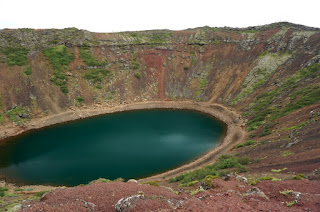July 29, 2019
One reason we came to Iceland this summer is because of the movie 'Journey to the Center of the Earth'. It is the 60th anniversary of this 1969 classic. The entrance cave was discovered inside the crater of Mt Sneffels just forty miles to our west. This Icelandic Volcano sits famously at the end of the long and skinny Snaefellsnes Peninsula which extends out to the West.
The overnight rain seems to be lifting. We begin driving west along the north coast of the peninsula. We pass the town of Grundarfjordur, which has two cruise ships anchored offshore. It seems Iceland is now a frequent port of call for cruise lines.
Our first stop is Kirkjufell Mountain. It is considered the most photographed mountain in Iceland. Probably because this steep sided basalt rock has a nice waterfall nearby. I pull out my tripod and try to get one of those silky smooth waterfall photos. It is difficult finding a rock high enough to place my midget tripod on to get above the weed line. Plus there is a constant stream of tourists passing through the scene.
The cloud level is starting to rise and we begin to get a good glimpse of Mt Sneffels. As I get out to take a photo, I am immediately attacked by dozens of Arctic Terns. These birds are notoriously territorial defending their nesting sites. They not only dive bombed me but also the car. It is not a fair fight as we see lots of dead Terns along the roadside. I stay longer around the Terns than I should have trying to get a good photo of one swooping at me. It is difficult as they fly extremely quickly.
As we near the end of the peninsula, we enter Snaefellsjokull National Park. The clouds have risen enough that we can now see the glacier atop Mt Sneffels.
Our next stop is the black sand beaches of Djupalonssandur and Dritvik. One beach has the remnants of an iron frigate that shipwrecked here some seventy years ago. There are also several stones fisherman used to lift for amusement. The other beach has strangely eroded basalt formations along the shore. Some of the rocks look like driftwood.
We next peruse some interesting storyboards at the Malarrif Visitor center. The Park Ranger tells us that the Arctic Terns we encountered have the longest migration of any animal. They spend summers in the Arctic and then travel to Antarctic waters in our winter.
Next up is the Londrangar Cliffs to check out other species of sea birds in the park. The sheer cliff wall is filled with noisy smelly Sea Gulls. Aimee and I were hoping for Puffins instead.
We then drove to the town of Arnarstapi on the southern coast of Snaefellsnes. We are hungry so we stop for Fish 'n' Chips made from locally caught Cod. Afterwards we took a walk along the coast back towards the town of Hellnar. In two spots we find the ocean has eroded a hole in the basalt cliffs forming an arch.
It has been a long day, so we skip the last couple stops and drive three hours to Reykjavik completing our Ring Road tour of Iceland. We are just in time for my cocktail hour.


















































